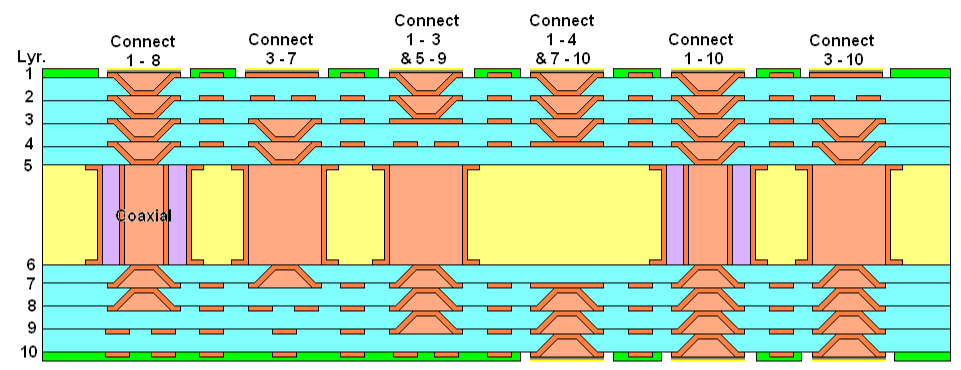Heavy Copper Printed Circuit Overview
- Nujay Technologies
- Aug 7, 2019
- 3 min read
Heavy copper printed circuit boards greatly increase power handling capabilities while providing a strong building block for extreme conditions.
Various new higher power electronic products, especially automobile and medical markets, are being designed every day to increase the current capability over a wide range of applications. These projects are taking advantage of a new trend in the printed circuit board industry, heavy copper circuits.
What defines a heavy copper circuit? Most commercially available PCBs are manufactured for low voltage/low power applications, with copper traces made up of copper weights ranging from 0.5 oz. /ft.2 to 3 oz. /ft2. A heavy copper circuit is manufactured with thicker copper between 4 oz. /ft.2 to 15 oz. /ft2. The increased copper weight combined with a typical FR4 base, transforms the low current circuit board into a durable, high power wiring platform.
Heavy copper circuits in their simplest form are manufactured by laminating heavy cooper sheets between 4 oz./ft.2 to 15 oz./ft.2 to a FR4 base followed by drilling and electroless plating . After imaging the via copper plating is added followed by etching to remove the copper and form the traces and pads. As the copper thickness increases, the extended time etching down through the thick copper to bare FR4 becomes a problem, resulting in a loss of trace definition and creating excessive undercut. Although this method produces thick copper traces, the thin copper in the vias does limit current flow between layers in the circuit board.
To make a more robust heavy copper circuit, a change is made in the process by starting with thinner copper base laminate and plating much more of the overall copper thickness required, resulting in a thinner base copper remaining to etch off. This produces finer trace definition with less undercut, the higher resolution traces are formed with a combination of thin base copper, thick dry film plating and etching, that results in straight sidewalls and negligible undercut, even at 10 oz./ft.2 of thick copper. Plating of a heavy copper circuit with a thin base copper of less than ½ oz. /ft.2 enables the board fabricator to increase the amount of copper thickness in plated holes and via sidewalls, by copper plating for hours. This thicker copper in the vias allows much higher currents, up to hundreds of amps, as well as providing a thick copper via on which to securely anchor power wires and connectors.
In printed circuit board testing for reliability, it is well known that via copper electroplating variation with hole/via sizes and plating times result in wide copper thickness variations. Areas of "thin copper" in the via wall will result in early via cracking failure during thermal cycling. Testing results clearly show this to be the case. Using heavy copper circuits with extra copper in the via, will reduce or eliminate these failures altogether. An additional 1 oz. /ft.2 of plated copper on a hole wall reduces the failure rate to almost zero. By design, heavy copper PCBs are virtually indestructible, which is important in applications, such as medical and military, where electronics failure is not an option. In effect, the thick copper circuit resists the expansion mechanical stresses placed on the vias by the thermal cycling.
Heavy Copper - Term used to identify copper conductors 3 oz. /ft.2 - 9 oz. /ft2.
Ultra Thick Copper - Term used to identify copper conductors 10 oz. /ft.2 or greater.
It is important to understand that for higher current designs the temperature rise due to current flow in the copper traces conductor must included when added to all other sources of heat in, or on the PCB.

See IPC-2222 for maximum operating temperature for laminate materials. Materials used, such as prepreg, copper-clad laminate, copper foil, heat sink, etc. and design requirements such as minimum dielectric thickness and spacing must be specified on the master drawing.
The heavy copper traces protrude from the surface higher than normal PCBs; high enough to make both soldermask and identification marking difficult. The photo imagable solder mask is usually flooded onto the surface, imaged and developed. On heavy copper PCB, the fabricator may roll or spray the photo imagable solder mask onto the surface which properly encapsulates the traces, including the side edges. White marking identification is difficult to silk screen close to tall heavy copper traces. Typically, the marking is placed only on raised copper traces or far enough away from a trace to enable the screen printer to print around the copper traces to the base FR4 laminate.

Heavy copper PCBs have a larger minimum trace width based on copper thickness. As the copper thicknesses go up, the trace width also goes up. Multilayer inner layer heavy copper PCB is limited to around 13 oz. /sq. ft. of copper thickness, due to its inability to fill in around the copper traces with prepreg. Increased heat and electrical ability can be achieved by adding extra vias to the large copper pads.




Comments